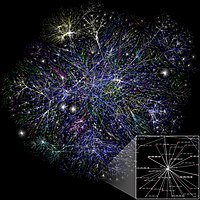
Photo from wikipedia
Network science has become a powerful tool to describe the structure and dynamics of real-world complex physical, biological, social, and technological systems. Largely built on empirical observations to tackle heterogeneous,… Click to show full abstract
Network science has become a powerful tool to describe the structure and dynamics of real-world complex physical, biological, social, and technological systems. Largely built on empirical observations to tackle heterogeneous, temporal, and adaptive patterns of interactions, its intuitive and flexible nature has contributed to the popularity of the field. With pioneering work on the evolution of random graphs, graph theory is often cited as the mathematical foundation of network science. Despite this narrative, the two research communities are still largely disconnected. In this commentary, we discuss the need for further cross-pollination between fields – bridging the gap between graphs and networks – and how network science can benefit from such influence. A more mathematical network science may clarify the role of randomness in modeling, hint at underlying laws of behavior, and predict yet unobserved complex networked phenomena in nature. What is the path towards a physical theory of complex networked systems? With an eye to the historical maths-physics duality, and an outlook towards the future, this commentary discusses promises and challenges accompanying the convergence of formal graph theory and data-inspired network science.
Journal Title: Communications Physics
Year Published: 2020
Link to full text (if available)
Share on Social Media: Sign Up to like & get
recommendations!